An interview with Eco designers / craftsmen
The purpose of my trip to Brazil was to research on how Brazilians embrace the new eco-consciousness of sustainability and what eco products the designers are creating as well as what the problems are if any at all. The reason why I chose this as my research is because while studying for my Bachelors degree, I designed quite a few sustainable products from reclaimed materials both for fashion and interiors. It was rather exciting to be able to fashion out functional decorative items from things that people consider to be valueless because as far as they are concerned the product has come to the end of its life cycle. My approach is that most things that have seemingly reached the ‘finish line’ can be given a second life by taking them as they are and develop new uses for them or if they have lots of components, take them apart and find something to do with each component part.
This led me to be curious about what other countries were doing. It’s alright for us as a developed economy to make proclamations and set targets to reduce carbon emissions by a given date. We can afford to do what is necessary in order to meet these targets. But what about the emerging economies? How are they coping?
In order to answer some of these questions, I researched sustainability in Brazil and their eco products before our departure and was very impressed that as an emerging economy, they certainly did seem to give consideration to the environment, evidenced by the number of innovative eco-products listed on a few websites of which the most impressive one was www.reviraideias.com.br (a website showcasing sustainable works by Brazilian designers) made from up-cycled materials.Below are examples of some works on the website :  Fig.1. A magazine rack made from old magazines –http://www.reviraideias.com.br
Fig.1. A magazine rack made from old magazines –http://www.reviraideias.com.br  Fig.2. Vase made out of plywood off-cuts – http://www.reviraideias.com.br
Fig.2. Vase made out of plywood off-cuts – http://www.reviraideias.com.br  Fig.3. Detail from a basket made from paper – http://www.reviraideias.com.br
Fig.3. Detail from a basket made from paper – http://www.reviraideias.com.br  Fig.4. Magazine rack made from corn-field waste – http://www.reviraideias.com.br
Fig.4. Magazine rack made from corn-field waste – http://www.reviraideias.com.br 
Fig.5. Close-up detail of a storage basket/tray made from ears’ of corn.http://www.reviraideias.com.br
The tropical gardens at the Jardim Botanico Do Rio De Janeiro, on the second day of our arrival, was very rewarding and a very good start to my research. After touring the Botanical gardens, Siobhan, a member of the group and I stumbled on the gift shop on the premises that stocked a whole range of items that were derived from nature. They had handbags made from the bark of palm trees, jewellery created from seeds and even flower pots made from the stump of the palm tree rather than letting it rot after its been felled or even becoming the victim of someone’s cooking stove.They were very impressive if only to provide alternatives to leather materials derived from farmed animals and a better use of seeds other than leaving them to rot or be served at the dinner table as food. All the seeds on further enquiry I was told are exclusive to the northern part of Brazil in the highlands. This confirmed my belief that my research into finding uses for conkers and acorns, the fruit of our chestnut and oak trees was very valid. During the conker season, the traditional thing in England is for kids to play a game of conkers using these fruit/seeds that have fallen from the chestnut tree. Heavens! There is even a championship for the conkers game! But I see it as a material with lots of potential.

Fig.6. My collection of conkers and acorns gathered from Woolwich in London.

Fig.7. Holding up one of the bags called a “Tururi” made from the bark of a palm tree. – Picture taken at the gift shop in Jardim Botanico Do Rio de Janeiro, Brazil with permission.  Fig.8. Detail of the bag.
Fig.8. Detail of the bag.  Fig.9. Seeded Jewellery in the showcase at the gift shop made from a seed called Patoa and bamboo – photo with permission –
Fig.9. Seeded Jewellery in the showcase at the gift shop made from a seed called Patoa and bamboo – photo with permission – 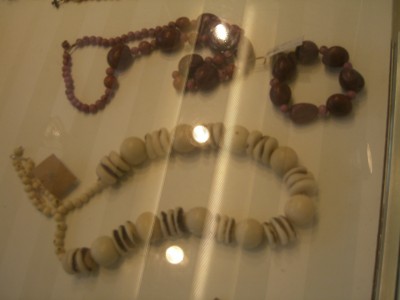 Fig.10. More necklaces made from “Jarina” in their natural colour – photo with permission –
Fig.10. More necklaces made from “Jarina” in their natural colour – photo with permission –  Fig.11. Earings made from seeds – photo with permission –
Fig.11. Earings made from seeds – photo with permission –
After this amazing find the preparations for the carnival was in full swing with everyday events of what they call the ‘Bloco’ which is Portuguese for street party. I discovered they have a “hippie” market which is the equivalent of our Spitalfields market here in London. So, I went to have a look and it turned out that there were all kinds of traders there amongst whom are craftsmen/women who have created their own sustainable products.
Janine Fortes happened to be one of the sustainable designers there with a stall where she displayed jewellery that she had made from bottle caps. Janine is a sculptor by profession and her love of jewellery made her look for a sustainable way of making jewellery which led to creating them from bottle tops. She also works in glass, making exquisite jewellery from molten glass. I have collected her contact details and emailed her a series of questions of which I am still waiting for her reply so that I can include it in my blog. However, she did express her willingness to look into a collaboration with me to make some sustainable products as well after looking at my blog and website.
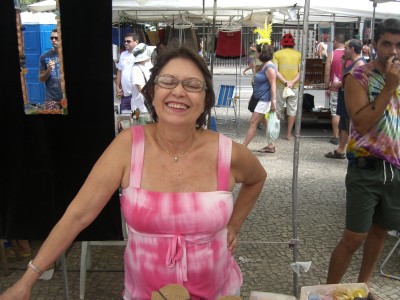
Fig.12. Janine Fortes at her stall in the ‘Hippie’ market, Rio de Janeiro – all photos with her permission –
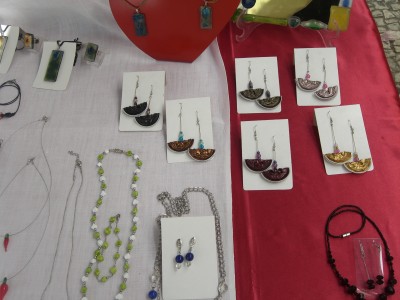
Fig.13. An array of her jewellery made from glass and bottle caps by Janine Fortes.
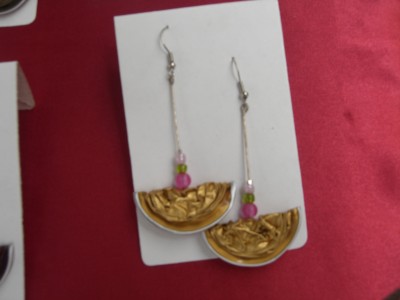
Fig.14. A bottle cap earing . Exploring the market got even better when I had the pleasure of meeting Luciano Jaguaribe who is also a sculptor and fine artist. Luciano makes lots of eco products from upcycled news papers and magazines. He makes table and stand alone lamps, fruit bowls, screens for doors/walls to name but a few using a marvellous technique of rolling up the paper and then using a mould in the desired shape, he then starts to build the bowl buy layering the rolled up strips and securing them with a glue. When they are dried he then applies resin and sometimes, varnish to laminate it. The same technique applies to all the different products that he makes. He also sculpts in metal. When asked what inspired this idea, he told me that he feels Brazilians are too dirty and non-challant about recycling. I interjected here that I don’t think they are dirty at all that the litter problems in Rio are the same in most major cities in the world. In England, it’s a big problem with people dropping litter everywhere. Although I feel there is a good reason why they are that way – they are not used to dropping things in the bin due to the fact that for a long time bins had been done away with in public spaces because of security issues. He then stated that he just wanted to help change their (Brazilians) attitude toward the different materials that are considered as waste. Chief amongst these materials are newspapers and magazines that are by-products of the fallen trees in the Amazon being made to waste with reckless abandon only to fell more trees and waste the products created thereof again. At this rate he said there would be no more forests! All the wildlife would have been destroyed and Brazil would be facing an ecological disaster. I pointed out to him that because we are a consumerist society, we generate a lot of waste from our life-style habits and I agree that people have to change this attitude not only in Brazil but the world over. The best way as designers is to look for ways that these so called waste can be re-absorbed and up-cycled into useful things, thereby reducing the incidence of waste and live more sustainably. To tackle this issue Luciano takes part in trade fairs and exhibitions where he showcases his work made from reclaimed materials. At one of such trade shows, he was approached and invited by the Italian government to conduct a series of workshops in Rome in order to increase the awareness of Italians about sustainable living by showing them different things that can be made from waste materials. He also does brisk business by selling his products made from newspapers and magazines. While I was at his stall conducting this interview, it wasn’t hard to see how popular his products are. Tourists and local people were buying a lot of his paper bowls because they were unusual and very well done. One of his very good customers and friend who did most of the translation because Luciano can’t speak English was telling me that his apartment was full of these paper products from bowls to lampshades and wall panels. He said he just can’t get enough of them because he loves them so much. I told Luciano that I have just started to organise workshops to teach people how to make useful things from waste materials and how they can use this to generate an income, most especially those who are out of work and still rely on benefits. If they are equipped with basic skills like this to make them more self-reliant, there probably won’t be that many people on the dole. Then I asked if he would be interested in conducting one of such workshops with me to which he replied he would be most delighted to take part and see what other things we can do together professionally. Here are some examples of Luciano Jaguaribe’s work….(all photos taken with his permission) 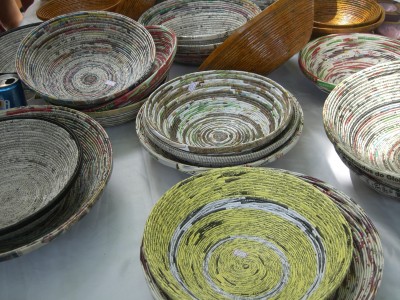 Fig.15. Bowls made from up-cycled newsprint as displayed in Luciano’s stall.
Fig.15. Bowls made from up-cycled newsprint as displayed in Luciano’s stall. 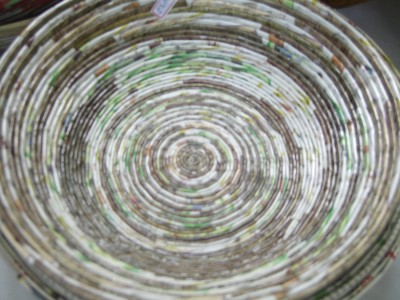 Fig.16. A large bowl detailing the clever technique of layering.
Fig.16. A large bowl detailing the clever technique of layering. 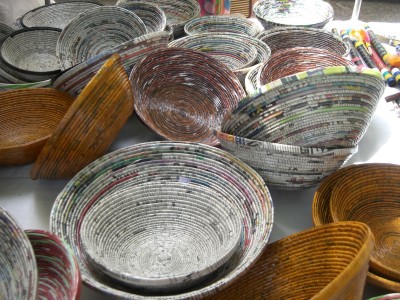
Fig.17. To decorate and colour the bowls, he has used their own newsprint colours and photos to serve as the decoration with such stunning results.
In my view, it seems to me that the Brazilians are doing very well already by creating such amazing products from reclaimed materials. Whether it’s jewellery or household items. It is very encouraging to see how popular they are with consumers, whether they are tourists or not. It seems to me that in a matter of time an emerging economy like Brazil will soon be the world leader in the production and sales of such low tech but innovative sustainable products. I also feel that Britain has a lot to learn from these humble people in terms of self-reliance and small-scale business innovation. Come to think of it, we in the United Kingdom have all the technology and resources at our disposal to create a thriving industry using either state-of-the-art technology or low tech ideas in the creative arts or otherwise, and yet we are still found wanting with unemployment at its highest level than it’s ever been since 1995.
According to reports released by the Office of National Statistics, on their website, dated March 2012, “… there are 2.67million unemployed people, up 28,000 on the quarter.”
I think this is because there is too much reliance on working for corporations when there aren’t even enough jobs to go round and most of these jobs require skilled workers of which some of the unemployed are not skilled enough to fill the available jobs that there are. There is a dearth in creative skills and too much reliance on technology which in itself is not a bad thing, but there should be more emphasis in the school curricullum to teach creative skills along with technological skills so that when people find themselves in such situations as they are today, they can utilise these skills to generate income for themselves and contribute to the economy by so doing. This will also take the pressure off the state in giving them unemployment benefits.
My next interview is a good case in point as to what people could do for themselves.Alberto Augusto Costa is a self-employed Brazilian designer and craftsman who makes functional decorative pieces with the use of seeds and pulses that are all obtained in Brazil. He carefully arranges the seeds in different patterns which include the very popular broken tiles design that is used to pave the side walks all over Rio de Janeiro, in a wavy and sometimes square pattern. Then he sets them in resin making them in all kinds of shapes; round, oval, spherical, and even square and rectangular slabs, big and small. A lot of his creations are made with the intention of them being used as breadboards, coasters, toast caddies/trivetts, or at best they could just be arranged in a particular way to create an abstracted design on the wall. What really attracted me to Alberto’s work was the fact that I myself have been researching the use of seeds to make functional things, but mainly jewellery. Stumbling on his work in Rio just took my breath away. I had to introduce myself and exchange contacts with him as well as schedule an interview with him. He was very friendly, but busy , because his unique pieces were just too good to carry on by and there were lots of trade drummed up from stop overs from both tourists and local people alike.
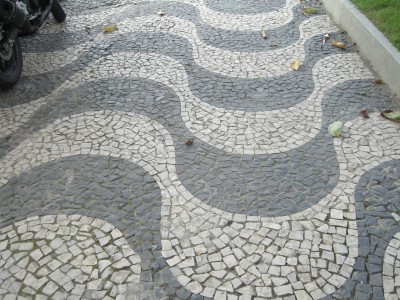
Fig.18. One of the very common wavy patterns of Rio de Janeiro’s sidewalk

Fig.19. Another example of the paving in Rio de Janeiro, Brazil.
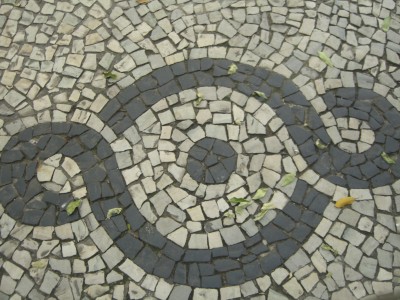
Fig.20. Another one of the many geometrics that dot the sidewalks. Below are the interview questions and answers: (All photos were taken with Alberto’s permission). ME: How did you start designing what you do? ALB: It all started 36 years ago when I was a young kid, an uncle gave me a craft set and from then on I was captivated. I used to encapsulate plants, rocks, insects etc then my first major break was when i made these into paper weights and people bought them. That was when i decided that this is what i want to do and have since veered away from these to making these table slabs and toast caddies. I have always earned my livelihood doing just this and nothing else. 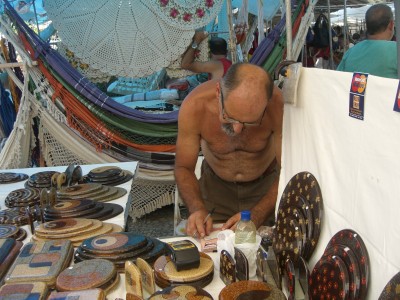 Fig.21. Alberto in his stall at the “hippie” market.
Fig.21. Alberto in his stall at the “hippie” market. 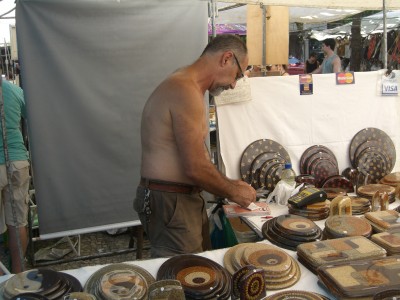
Fig.22. Taking stock .
ME: What’s the market like today compared to when you just started?
ALB: The market is very good. It’s always been the same or even better now than before because people appreciate a good handicraft.
ME: Your work is so unique. It is very different from anything I have seen before, particularly because it’s made of seeds. I have been thinking along the same lines as you, but mine was to utilise seeds from fruits and trees in our parks and make jewellery from them because I believe they are not entirely useless. What really inspired this idea of your’s?
ALB: My idea came from the fact that Brazil is full of all kinds of seeds and pulses and I just wanted to do something different and interesting that had never been done before. I also wanted to show that these seeds and pulses need not only be used for food, that they can be used as materials for decorative and functional household items. One could either just hang them on the wall as a decoration because they have their own aesthetic or use them around the home where they can be appreciated as an art piece as well as something useful. In my house, I have some of these on the wall which have slight defects and so therefore I drilled a hole in them and hung them on the wall and they do work.
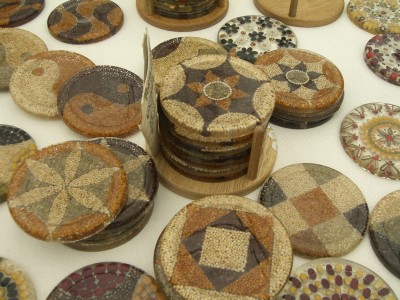
Fig.23. An array of coasters with geometric shapes made from seeds and pulses.

Fig.24. As can be seen the seeds used are corn, all sorts of beans and guinea corn.

Fig.25. Dinner place mats with a contemporary modern design.

Assorted species of beans and corn can be seen in the stack of round slabs.
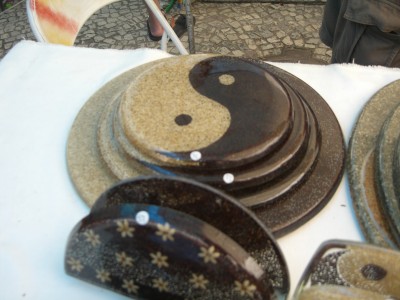
Fig.28. “Ying and Yang” the japanese symbol of duality in a stack of placement slabs. ME: When you started out, did you get help from the Brazilian government or self-fund? ALB: I never got help from the government, my mother too used to make these kinds of stuff and she encouraged me and also lent me her support. My brother does the same thing (pointing in the direction of the stall across from him) But their styles are different. They do more figurative and picturesque themes using plants and grains of sand. ( We go over to the stall and there are an array of discs which could be used as coasters or just simply as a decorative plaques, all delicately depicting scenes of the country-side, animals or just landscapes). 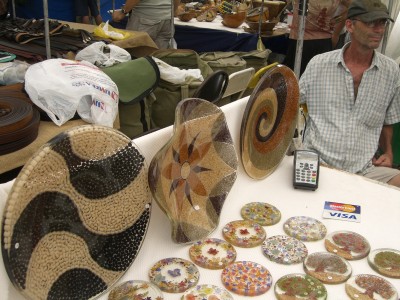 Alberto’s brother and his own array of fruit bowls and coasters.
Alberto’s brother and his own array of fruit bowls and coasters. 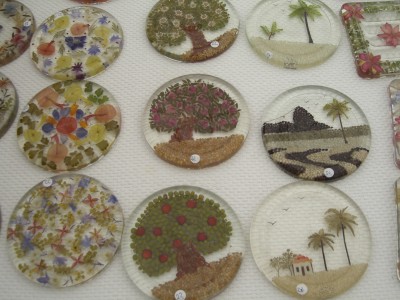 Fig.30. Encapsulated plants and a scene of Copacabana beach with the ‘sugar-loaf mountain in the background created by Alberto’s brother.
Fig.30. Encapsulated plants and a scene of Copacabana beach with the ‘sugar-loaf mountain in the background created by Alberto’s brother.
ME: In your estimation, how are Brazilians embracing the idea of sustainability and ecological designs? ALB: I don’t know. I think people are more aware of the waste and the pollution that they are generating and they are starting to come round to the idea, but still as you can see Brazil dirty. ME: Well compared to England where I come from Brazil is not dirty at all. I notice that there are bins in every corner and lots of recycle bins in the street and public buildings. People don’t throw waste on the floor as they do back home. ALB: Yes, that is true. We are all starting to recycle in our homes but there is still a long way to go. There are still lots of pollution from chemicals and petroleum products. ME: Have you thought about reaching outside markets other than Brazil? ALB: (Thoughtful) No. I don’t really want to go outside of Brazil because i don’t have the capacity to meet the demand that may result. Each of these slabs entails long processes and it will be too much for me to do on my own. ME: Do you have a studio or workshop where you make these or do you do them at home and do you have an assistant? ALB: Yes, I have a studio and an assistant who helps me out. She has been working with me for a while now and she comes in whenever I have to make a new batch of products. ME: How do you manage to get each and every piece looking so perfect? The reason why I ask this is because I have tried working with resins and they are the most difficult materials to work with. ALB: It is not that difficult once you get the right balance in the measurement ratios and understand the right conditions that it needs to cure properly. I have many years of experience using resins and have experimented with lots of methods. Practice makes perfect. ME: What do you use as moulds or rather how do you make your moulds? ALB: Moulds can be made from all sorts of materials. But I cannot tell you all my secrets.(We both laugh) ME: I know you don’t want to divulge your secrets, but I am still very intrigued at your work and how perfect they look. Do you also use a degassing chamber? ALB: What is a degassing chamber? ME: It’s a kind of pot that helps to remove any trapped air in the mixture of the resin. It creates a vacuum that then sucks out all the trapped air and then enables a crystal clear resin cast. The only problem is that you can only put so much in it at a time and probably won’t be suitable to make large quantities of casts. I would like to know what other alternatives there are which is part of the research I am carrying out here in Brazil. I appreciate that most crafts people probably don’t use state-of-the-art equipment to do their work and they may have alternative ways of going about things. Therefore, I would like to find out some of them. ALB: Ah, no I do not use the degassing chamber. I know what it is now. It uses a vacuum. I have my own methods, for instance, when mixing the resin, if you prepare it carefully, and don’t stir it too vigorously, you will have less bubbles trapped inside. I also use a sharp poke made of wood and I deflate the bubbles one by one. ME: Really? That must take a lot of pains-taken work to do especially when there are so many of them that have to be done. (Something tells me he is not being very honest here). ME: If i wanted to get discs made of a certain diameter that would be used for some of my own sustainable designs, if i gave you the measurements, can you do this? ALB: (He is thoughtful) It is very hard to get any other shapes made other than the ones I have made here. These are my own standard measurements and were made specially. ME: What do you mean? Is it not a matter of making the moulds to the exact size? (He considers for a moment then states) “I don’t want to tell you my secret.” ( I cajole him a little and assure him I will keep it to myself as I want to learn from him). He did tell me what he uses for his moulds but I promised not to divulge it during my publication. ME: Would you be interested in a collaboration or selling your products online in the UK?
ALB: I am not sure. Like I said before, I do not have the capacity to meet that kind of demand. ME: What about if I advertised your products on my website and bought some stock from you which I then get to sell on my website? ALB: You can buy some of the stock but what happens if people want several of a particular one and they have to wait for it to be produced? ME: Well, there will be a period of grace to get the products delivered, so it will always have what numbers of a particular stock are available and we’ll give up to six weeks between ordering and delivery. In that time we can have it shipped out to England. ALB: Also, I don’t want to pay for packaging and delivery. ME: Don’t you worry, I will sort that out. ALB: Ok. (He doesn’t seem too convinced). ME: Would you like the idea of a collaborative workshop? I conducted a workshop last year and the aim of the workshop is to equip the unemployed young school leavers, and those who are living on government support, with skills to make them able to become self employed and earn a living. I believe together we can organise a workshop which will be paid for to cover your expenses. Would you be interested in this? ALB: Yes, i would like that very much. I like to be able to help people from deprived backgrounds and poor countries to learn skills to be able to help themselves. Such countries in Africa or India, I would find that very satisfying. ME: How hard is it to be an ecological/sustainable designer in Brazil?
ALB: I am not sure. ME: Do you consider yourself as one? ALB: (After careful consideration) I am just an artist, a craftsman. ME: Yes, but you are making things out of seeds and pulses, making people see that there are other uses for these things rather than just eat them, throwing them away as waste or leaving inedible seeds to rot. ALB: I am not too sure about that to be honest. This is just my livelihood. ME: What advice would you give to someone who is just starting out to be an eco designer? ALB: (Thinks hard) I don’t know what to say there. (Laughs). ME: Would you say they need to be determined to succeed, persevere, take risks and try to be good at what they do as well as be full of passion? I think without these basic ingredients, you won’t have been as successful as you are today. ALB: Yes, it’s very true. ME: How do you think the Brazilian government can help and encourage eco designers and artists?
ALB: (After a long consideration) I don’t know to be honest.
ME: Don’t you think the government can help by providing a common roof under which all those of you who make things like this can exhibit and sell your products? When people who are after ecological products need to look for such things they would know where to look. Also, I think that the government can help provide funding to small-scale businesses like yours and lend the support to attract international trade.
ALB: That is very true. But there is the problem of also meeting demand of that scale as I said before.
There ends my interview with Alberto.
It seems to me after cross-examining the various craftsmen and woman, that everyone of them relies on the support of either friends and family to set up shop. They all come to this market every Sunday and seem quite satisfied with the level of trade that they are getting.
Brazil is an exotic tourist destination and they would never be short of tourists who will purchase these sorts of products as souvenirs to take back home with them. I believe if they are very ambitious, they could become an international sensation in sustainable arts and craft. At the moment, they seem to be content with just making enough to earn a living, which is very commendable and fills me with a lot of respect for them because they are humble people just using their skills to sustain themselves.
However, it is true what they said about Brazilians being non-challant and wont to create litter. During the Carnival, as my group left the Superdrome, which was the venue of the Rio carnival, I was very disappointed to see that some of the costumes that were used for the show had been abandoned by the roadside. There were headresses and complete costumes left for anyone who was interested to pick up. I was quite tempted to take one but thought it would be a monstrousity to take with me on my flight back to England.
Once the costumes have served their purpose, they are never reused because every year they have different themes. But I still feel their is a market for these kinds of garbs which can be absorbed in the entertainment industry around the world. Some of them are not as gigantic at all.
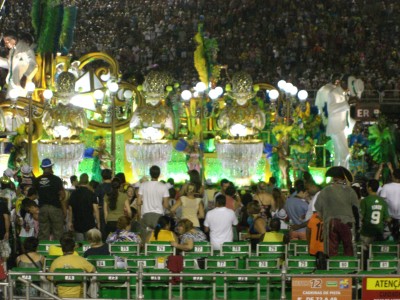
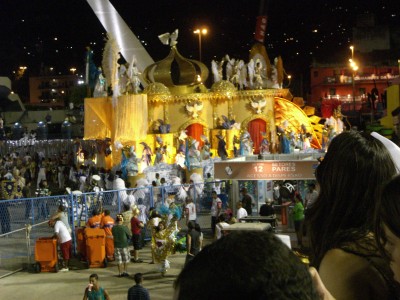
Fig.32. A very colourful display of another Carnival float with dancers in feathered costumes on the top.

Fig.33. Me and a couple of lady revelers at one of the street parties which heralds the carnival. Everyone dresses up to be outrageous with whatever colourful costumes they can put together.
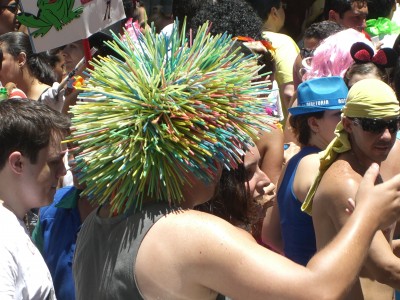
Fig.34. The only costume that I saw worn by a reveller at a Bloco, this headress was made from drinking straws.
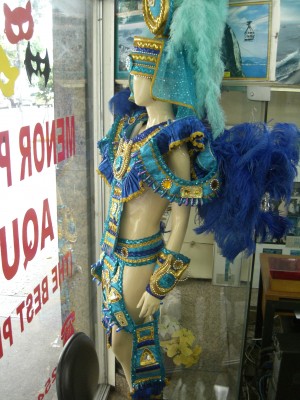
Fig.35. This Eygyptian themed costume was lucky to make it into a shop window and the shop owner was kind enough to let me take a picture. Apart from the Carnival, I wanted to discover Brazilian textiles. A trip to Ilhe Grande led me to one such shop where they showcase and sell such products. It was very difficult to have a conversation with anyone that could lead me to such places where Brazilian textiles are abound, this is due to the fact that not many people spoke English, which was very frustrating. So, I had to make do with relying on my instincts and kept my eyes peeled. Anyhow, I found this shop that sold handmade textiles and the one that I found unique and interesting was made from what looks to me like a plastic mesh ( the kinds used to mark off construction sites in England). They had it cut into strips of about two inches wide and more than a foot long. The small squares were then woven with wool into crosses using the structure of the mesh as support. I felt this was very clever use of what usually gets thrown away after use on building sites in England. 
Fig.36. A textile made from plastic mesh and wool meant to be a hair band.
Conclusively, it is quite obvious that there in no end to the wonderful and innovative ideas that Brazilian designers and artists are able to come up with whether we want to see their work as a mere craft or sustainable products. They are also pulling their weight in the drive to be eco-friendly by reusing materials that will otherwise be discarded and giving them a new lease of life to be used at home or as fashion accessories. I hope everyone who gets to read this material can at least be inspired by the research and look around to see how as designers they can also make a difference in our consumptive society, by reducing waste, reuse and recycle.
Note of appreciation
My sincere note of thanks goes to all the various artists who were able to set time aside for me in their busy schedules to grant me an interview. Through them I have been able to feel the pulse of creative Brazil and without them, my trip would have come to nought. I already arranged to meet the owner of the Reiraideias website, Alexandria, who was going to connect me with the artists that displayed work on his site, but due to his own busy schedule, I was not able to get the promised contacts and was faced with disappointment at achieving the main purpose of going to Brazil.
I would also like to thank Alexandria as well for taking an interest in my mission and taking the time to communicate with me via email. I hope that in the future we can possibly carry out some of the ideas that we discussed.
Regards,
Adey Thani
Textile Designer (BA HONS)
Editor; Creative Scruples Blog.

